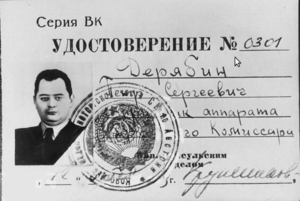Peter Deriabin
Peter Sergeyevich Deriabin (Russian: Петр Дерябин; 1921 – 1992) was a KGB officer who defected to the United States in 1954. After his defection, he worked for the Central Intelligence Agency, and wrote several books on the KGB. He died in 1992 at the age of 71.[2]

Pre-defection life and career
Deriabin was born in Siberia's Altai region.[3] He was a member of the Communist Party. He went to Biysk Teachers College as well as the Institute for Marxism-Leninism.[2] In World War II, he was wounded four times and was reassigned to the Soviet Navy's SMERSH (military counterintelligence group). He was later an investigator with the People's Commissariat of Internal Affairs (NKVD), where he eventually moved up to the organization's headquarters and gained the rank of Colonel.[3][4] Deriabin was Stalin's bodyguard for a short while, and accompanied him to the conferences at Yalta, Tehran and Potsdam.[5][3]
Defection and subsequent career
Defection
In 1953 following Stalin's death, Deriabin was stationed in Vienna as Chief of Soviet Counterintelligence as well as Communist Party boss for the entire Austro-German section. In 1954, he defected to the United States "via a freight train ride through Soviet occupied territory near Vienna," and was the highest ranking Soviet intelligence officer to have done so at the time. [5][6] In retaliation, the Military Collegium of the Supreme Court of the USSR sentenced him to death in absentia.[2][5] He testified before the US Senate and the HUAC in 1959, and co-wrote a book about his time in the KGB.[7]
Work with the CIA
Deriabin went to graduate school at the University of Michigan and the University of Virginia,[2] and joined the CIA.
A few days after the assassination of President Kennedy, Deriabin wrote a lengthy memorandum for the CIA, in which he theorized that Oswald was a Russian KGB agent who either was dispatched to kill Kennedy or was sent to the United States on a different mission and then committed the assassination on his own.[8] Deriabin contended that the Russians would have accomplished several objectives by eliminating Kennedy. Among them was removing the West's preeminent cold warrior from the scene, constraining US covert actions against Cuba, which would be stigmatized as acts of vengeance, as well as divert the Russian people's attention from their many domestic problems.
He was also involved in the Yuri Nosenko case as an interrogator,[9] a controversial Russian defector who was treated harshly by the CIA (including solitary confinement) and presumed to be a KGB plant for at least a year before he was released. Deriabin was one of the CIA officials who believed he was a plant, claiming that the details of Nosenko's stories about his experiences in SMERSH and the KGB didn't match up with Deriabin's own experience in those agencies.[4]
Deriabin was considered an asset when the NSA ramped up operations in the 1970s, and entered the agency's ranks during a visit to Fort Meade in 1973. A detailed report of his visit was declassified in 2012.[10]
Deriabin retired from the CIA in 1981.[2]
Death
Deriabin died following a stroke on 20 August 1992 in Northern Virginia.[5] At the time of his death, he was survived by family members whose names were kept secret by the CIA.[2] According to the CIA, Deriabin's knowledge and understanding of the KGB was "the foundation for the West's knowledge of the agency."[5]
Books
He co-authored several books.
- The Secret World, with Frank Gibney, Doubleday, 1959
- Watchdogs of Terror, 1984, University Publications of America[11]
- KGB, Masters of the Soviet Union, with Tennent H. Bagley, Hippocrene Books, 1990[12]
- The Spy Who Saved The World, with Jerrold L. Schecter, Scribners, 1992[13]
- Inside Stalin's Kremlin, Brasseys Publications, 1998 [14]
- Deriabin gave a detailed account of his views on the Nosenko case to Tennent H. "Pete" Bagley, which were published in Bagley's book Spy Wars, released in 2007.[4]
References
- KGB Identity Card, originally from Life Magazine Jan 01, 1959, copyright exempt because of commons:Template:PD-RU-exempt
- Peter Deriabin, 71, A Moscow Defector Who Joined C.I.A. Published: August 31, 1992, New York Times
- "Obituary: Peter Deriabin". The Independent. 1992-09-10. Retrieved 2020-08-13.
- Bagley, Tennent H. (2007), Spy Wars: Moles, Mysteries, and Deadly Games, Yale University Press (also available on audio, read by Bagley)
- Service, New York Times News. "PETER DERIABIN, DEFECTOR FROM KGB". chicagotribune.com. Retrieved 2020-08-13.
- A Soviet Defector at NSA Archived 2013-09-18 at the Wayback Machine
- Postwar Soviet Espionage, a Bibliography, vol 6 n 2. Center for the Study of Intelligence, CIA, p A35
- "DCI John McCone and the Assassination of President John F. Kennedy, p. 3. Studies in Intelligence vol. 57, no. 3 (September 2013)" (PDF).
- region, Ian ShapiracloseIan ShapiraEnterprise reporter covering the Washington; beyondEmailEmailBioBioFollowFollow. "'Foul traitor': New JFK assassination records reveal KGB defector's 3-year interrogation". Washington Post. Retrieved 2020-08-13.
- https://www.nsa.gov/news-features/declassified-documents/cryptologic-spectrum/assets/files/soviet_defector_nsa.pdf
- Watchdogs of terror: Russian bodyguards from the tsars to the commissars, Peter Deriabin, University Publications of America, 1984. google books
- The KGB: Masters of the Soviet Union by Peter Deriabin with Tennent Bagley, 1990
- Schecter, Jerrold L.; Deriabin, Peter S. (1992). The Spy Who Saved the World: How a Soviet Colonel Changed the Course of the Cold War. New York: C. Scribner's Sons. pp. 284. ISBN 978-0-684-19068-6.
- Inside Stalin's Kremlin, Brasseys Publications, 1998